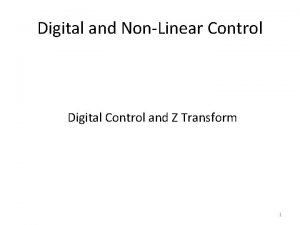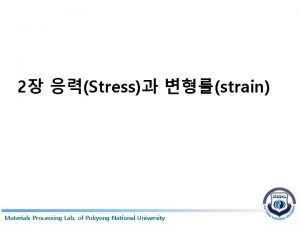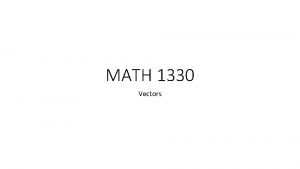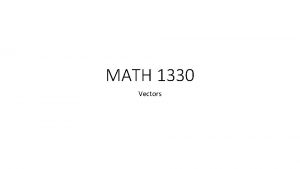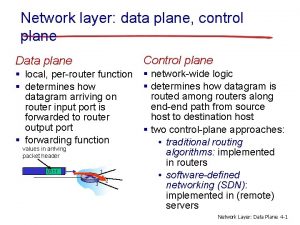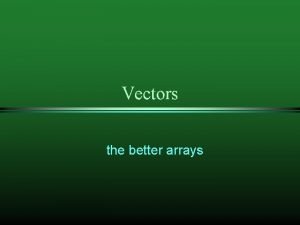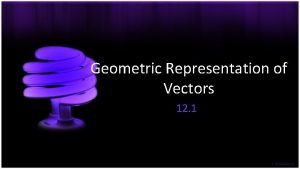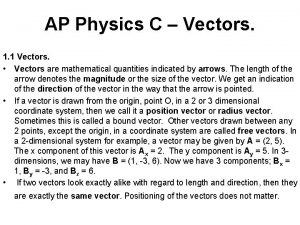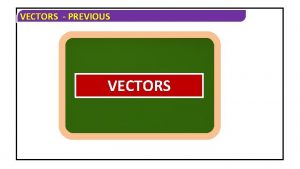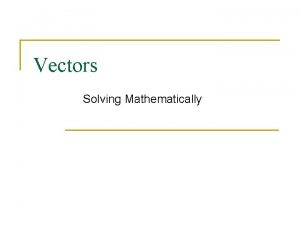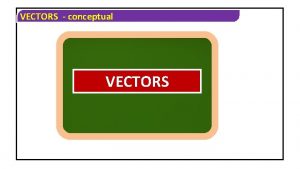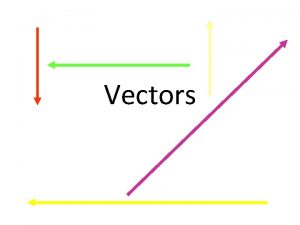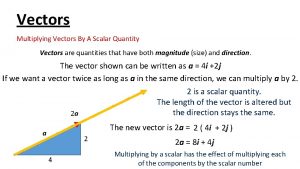MATH 1330 Vectors Vectors in a plane The







































- Slides: 39

MATH 1330 Vectors

Vectors in a plane The arrow at the terminal point does not mean that the vector continues forever in that direction. It is only to indicate direction. e en r t s or iz (s h) t g the terminal point is the ending point de u it gn a m a rs cto Ve ve a h The initial point is the starting point Vectors have a direction (slope or directional angle).

Component Form of a Vector To determine the component form of a vector, v, with initial point P (a, b), and terminal point Q (c, d), you must subtract: terminal point – initial point. v = <c – a, d – b>.

Component Form of a Vector To determine the component form of a vector, v, with initial point P (a, b), and terminal point Q (c, d), you must subtract: terminal point – initial point. v = <c – a, d – b>. This is the vector translated so that the initial point is at (0, 0).

Place the following vectors into component form: u: Initial Point: P (4, -2); Terminal Point (5, 1).

Place the following vectors into component form: u: Initial Point: P (4, -2); Terminal Point (5, 1). u = <5 - 4, 1 - (-2)> = <1, 3>

Place the following vectors into component form: u: Initial Point: P (4, -2); Terminal Point (5, 1). Notice, this is the coordinates of the “new” terminal point u = <5 - 4, 1 - (-2)> = <1, 3>

Place the following vectors into component form: u: Initial Point: P (4, -2); Terminal Point (5, 1). Also, notice that they will both have the magnitude and direction. u = <5 - 4, 1 - (-2)> = <1, 3>

Find the component form of: v: Initial Point: P (0, 4); Terminal Point (9, -3). w: Initial Point: P (-2, 5); Terminal Point (7, 2).

Finding Magnitude and Directional Angle: If you needed to calculate the distance between the terminal and initial points of a vector, what formula can you use?

Finding Magnitude and Directional Angle: •

Finding Magnitude : •


This means the Magnitude of v

Finding Directional Angles If you needed to calculate the angle between the positive x-axis and a vector in standard position, how would you use this?

Finding Directional Angles If you needed to calculate the angle between the positive x-axis and a vector in standard position, how would you use this? How can the unit circle be used here? What trigonometric functions can be used?

v = <v 1, v 2>

Finding Directional Angles •

Finding Directional Angles •

Writing Vectors Any vector can be defined by the following: v = <||v||cos θ, ||v||sin θ>

Determine the magnitude and direction of: <8, 6>, <-3, 5>

Determine the component form of the vector with magnitude of 5 and directional angle of 120 o.

Vector Operations: <a, b> + <c, d> = <a + c, b + d> <a, b> - <c, d> = <a - c, b - d> k <a, b> = <ka, kb>

Resultant Force The Chair Example!

Resultant Force Two forces are acting on an object. The first has a magnitude of 10 and a direction of 15 o. The other has a magnitude of 5 and a direction of 80 o. Determine the magnitude and direction of their Resultant Force.

Look at this situation graphically (parallelogram) or analytically (operations on vectors).

Unit Vectors To calculate a unit vector, u, in the direction of v you must calculate: u = (1/||v||)<v 1, v 2>.

Find the unit vector in the direction of the following: <3, 5> <1, 8>.

Linear Combination Form: Standard Unit Vectors: i = <1, 0> j = <0, 1>

Linear Combination Form: Standard Unit Vectors: i = <1, 0> j = <0, 1> If v = <v 1, v 2> = v 1 <1, 0> + v 2 <0, 1> = v 1 i + v 2 j

So convert the following w = <3, -5> into linear combination form.

The Dot Product of Two Vectors Vocabulary: Angle between vectors: The smallest angles between two vectors in standard position Orthogonal Vectors: Vectors that are at right angles.

Calculating the dot product of two vectors Consider u = <a, b> and v = <c, d> u · v = ac + bd

Determine value of <7, 5> · <9, -1> Determine value of <6, 1> · <-5, 3>

Angles between Vectors •

Determine the angle between the vectors: u = <9, 3>; and v = <4, 8>.

Determine the angle between the vectors: u = <0, 4>; and v = <3, 9>.

Give a possible vector that would be at a right angle to <7, -2>?

Give a possible vector that would be at a right angle to <7, -2>? What general rule can you use to determine orthogonal vectors?
 Software-defined networking: a comprehensive survey
Software-defined networking: a comprehensive survey Decreto 1330 de 2019 ppt
Decreto 1330 de 2019 ppt Engr 1330 ttu
Engr 1330 ttu Navpers 1330-3
Navpers 1330-3 Engr 1330
Engr 1330 Zuzana 1330
Zuzana 1330 Ib math
Ib math Mapping between s plane and z plane
Mapping between s plane and z plane 후크의 법칙
후크의 법칙 Forwarding equivalence class
Forwarding equivalence class Topmarks
Topmarks Tư thế ngồi viết
Tư thế ngồi viết ưu thế lai là gì
ưu thế lai là gì Thẻ vin
Thẻ vin Cái miệng nó xinh thế chỉ nói điều hay thôi
Cái miệng nó xinh thế chỉ nói điều hay thôi Thể thơ truyền thống
Thể thơ truyền thống Các châu lục và đại dương trên thế giới
Các châu lục và đại dương trên thế giới Từ ngữ thể hiện lòng nhân hậu
Từ ngữ thể hiện lòng nhân hậu Diễn thế sinh thái là
Diễn thế sinh thái là Frameset trong html5
Frameset trong html5 Thế nào là giọng cùng tên
Thế nào là giọng cùng tên 101012 bằng
101012 bằng Bài hát chúa yêu trần thế alleluia
Bài hát chúa yêu trần thế alleluia Hổ đẻ mỗi lứa mấy con
Hổ đẻ mỗi lứa mấy con đại từ thay thế
đại từ thay thế Vẽ hình chiếu vuông góc của vật thể sau
Vẽ hình chiếu vuông góc của vật thể sau Quá trình desamine hóa có thể tạo ra
Quá trình desamine hóa có thể tạo ra Cong thức tính động năng
Cong thức tính động năng Thế nào là mạng điện lắp đặt kiểu nổi
Thế nào là mạng điện lắp đặt kiểu nổi Lời thề hippocrates
Lời thề hippocrates Dạng đột biến một nhiễm là
Dạng đột biến một nhiễm là Bổ thể
Bổ thể Vẽ hình chiếu đứng bằng cạnh của vật thể
Vẽ hình chiếu đứng bằng cạnh của vật thể Phản ứng thế ankan
Phản ứng thế ankan Các môn thể thao bắt đầu bằng tiếng chạy
Các môn thể thao bắt đầu bằng tiếng chạy Sự nuôi và dạy con của hổ
Sự nuôi và dạy con của hổ điện thế nghỉ
điện thế nghỉ Một số thể thơ truyền thống
Một số thể thơ truyền thống Biện pháp chống mỏi cơ
Biện pháp chống mỏi cơ Trời xanh đây là của chúng ta thể thơ
Trời xanh đây là của chúng ta thể thơ







